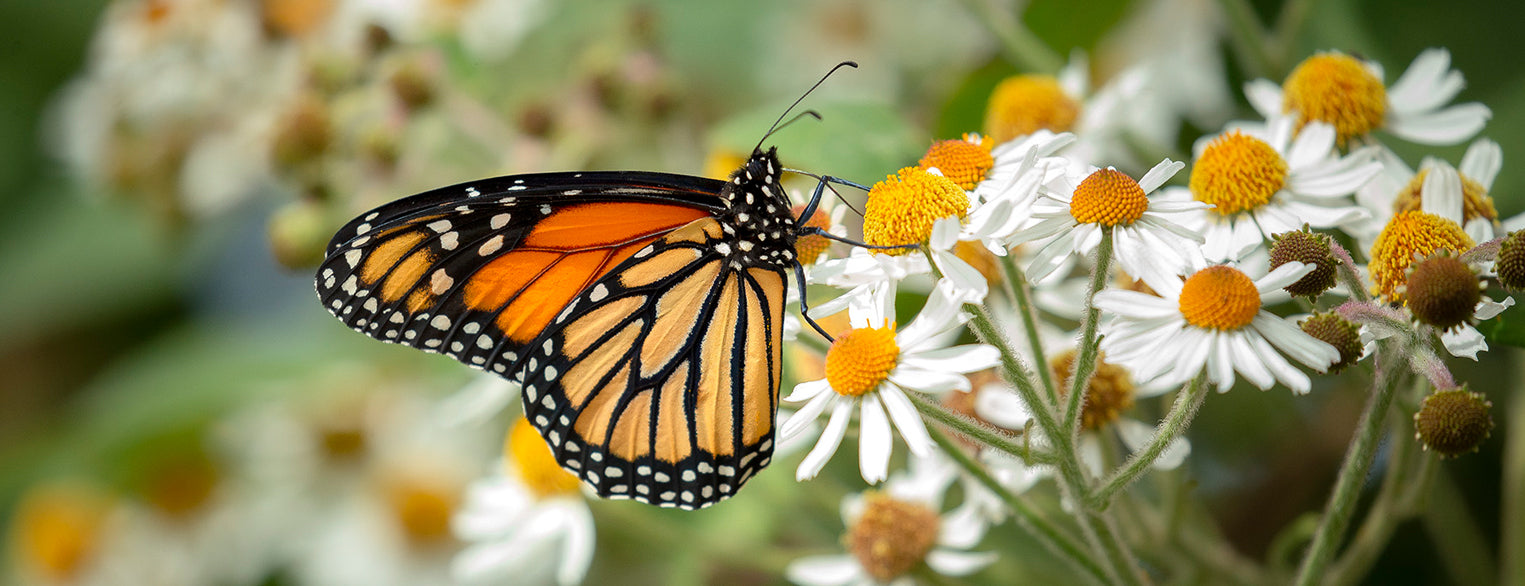Shop All
ADULTS
KIDS
TOYS & BOOKS
FOR THE HOME
ADULTS
KIDS
TOYS & BOOKS
FOR THE HOME
ICONIC & ECO-FRIENDLY
Wildlife
Deals
The Wing's the Thing
April 25, 2023 4 min read

Butterflies–Delightful Diversions
By Wendy Perkins*
Butterflies and moths make up one of the largest and most recognizable groups of insects, the Order Lepidoptera. Derived from the ancient Greek words for “scale” and “wing,” the name perfectly describes a key characteristic of moths and butterflies: the tiny, keratin-based scales that cover their wings. Over time, lepidopterists (people who study moths and butterflies) have identified more than 274,000 species—and there are many more to discover.
Wings can also provide a clue as to whether one is looking at a moth or butterfly. Generally, a resting butterfly holds its wings together vertically above its body, while a moth’s wings are splayed out to either side or pressed close to its body. Sometimes, people mark the difference based on whether or not the creature’s wings are colorful—generally assuming that colorful wings are those of a butterfly while moths wear more drab shades. But if you’re familiar with the old adage “You can’t judge a book by its cover,” you won’t be surprised to learn that there are some stunningly colorful moths, or that when a butterfly is resting with its wings up, you only see the dull, patterned camouflage under the wing.
Variations on a Theme
Wing markings are important to the survival of Lepidoptera. The bright colors sported by some species are a way of communicating to would-be predators: “I’m toxic, don’t taste!” Some butterflies mimic this warning coloration even though they aren’t toxic. One of the interesting things about color and pattern on butterflies is the variation among members of the same species.
With a widespread distribution throughout Central and South America, the red postman Heliconius erato has about 29 different geographical forms. The basics are black wings with red and white markings. But the tint and size of the patterns vary depending on where the population is located. The designs speak volumes, and experts can use them to say just where a specimen came from.
The monarch butterfly Danaus plexippus is probably one of the most recognizable species and is famous for making a 3,000-mile migration to escape winter temperatures. Actually, an individual monarch doesn’t make the full migration; the butterfly that ends up in the warmer wintering locale is the fourth-generation descendent of one that left the summer feeding grounds. By studying each generation, an interesting occurrence has come to light. For reasons not yet understood, butterflies that arrive at the wintering grounds have darker-colored wings than their predecessors that stopped along the way.
Mud, Sweat, and Tears
Mention butterflies, and many people automatically see an ephemeral creature perched on a blossom, quietly feeding. That’s a good place to start, but the next time it rains, be sure to watch for butterflies drinking from mud puddles. Males engage in this behavior, known as “puddling.” Plunging their proboscis (tongue) into the muck, the males are able to extract minerals that aren’t available from flowers. They’ll pass the salts on to females they mate with, which need them for egg production. Because they mate with more than one female, males return to damp or muddy soils over and over.
In places like a rain forest, where the soil may be inaccessible, butterflies and moths get vital minerals from other sources. Some make the most of the sweat of other animals, and a few have been seen “drinking” blood from open wounds. The Julia butterfly Dryas iulia doesn’t always wait for the right circumstance, however. This bright-orange marvel has been observed landing beside a caiman’s eye and dipping into crocodillian tears!
Sip or Soak?
Since they have no chewing mouthparts in their adult phase, moths and butterflies survive—and thrive—on a liquid diet. Their proboscis has long been described as functioning like a straw, making it easy for the insect to suck nectar up from the depths of a flower. Recent studies have shown, however, that it works more like a piece of paper towel than a drinking straw. Simply put, butterflies and moths soak up their food rather than sip it. Wondering how a moth “absorbs” your wool sweater? It doesn’t; the moth larva eats the wool, which is why the non-feeding adults laid eggs there.
Most adult forms of moths and butterflies rely on nectar to fuel their flight as they search for mates. Zebra longwings Heliconius charitonia are also able to use pollen as a food source. They collect the powdery substance and break it down into a liquid in order to absorb important amino acids. This extra bit of nutrition is a bonus; rather than a two- to four-week period of egg laying, zebra longwings are able to procreate for about six months!
In the wonderful world of Lepidoptera, there aren’t really rules, but guidelines. Remember, there are always exceptions, and those are likely to be exceptionally amazing!
Show your love for these vibrant pollinators while supporting our mission to care for wildlife. Your purchase of butterfly tees, hats, tote bags, and drinkware has a positive impact on our organization's conservation efforts. Please be an ally in restoring monarch and butterfly populations worldwide by shopping our butterflies collection here.
*As seen on San Diego Zoo Wildlife Alliance Stories.
Leave a comment
Comments will be approved before showing up.
Newsletter
Find out about our newest arrivals and get special offers in your inbox!

Be a Wildlife Ally
Discover a wild array of products at ShopZoo, where every purchase helps save, protect, and care for wildlife.
Find out about our newest arrivals and get special offers in your inbox!

